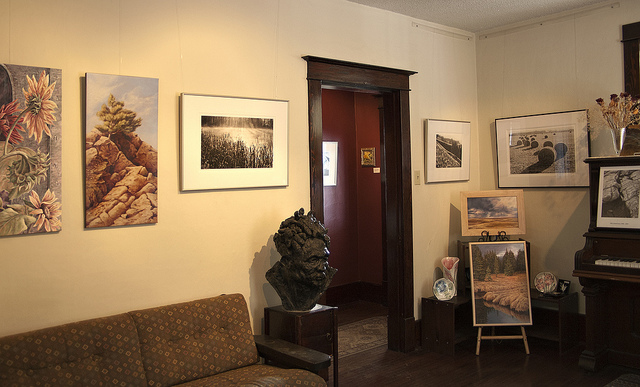Where earth meets sky: Wetaskiwin’s dynamic arts scene
A stop at Caelin Artworks is a must

The Alberta city of Wetaskiwin is noted for its thriving automotive industry, with the Reynolds-Alberta Museum dedicated to “the spirit of the machine,” and the city claiming the highest car sales per capita in Canada. However, if you dig a little further, the city, whose name comes from the Cree for “the hills where the peace was made,” has become the home base for many visual artists, perhaps drawn by the sweep of the prairies and the tranquillity of rolling hills brushing that wide prairie sky.
For travellers with an appreciation of prairie-inspired art, a stop at Caelin Artworks is a must. The gallery is run by couple Colleen McGinnis and Leon Strembitsky, a painter and photographer respectively, who have established roots in the central Alberta town.
McGinnis grew up on a farm outside of the community. Strembitsky was born and raised in the city and worked as a commercial photographer in Ontario and Edmonton before returning to his beloved Wetaskiwin. Though they wouldn’t trade their prairie idyll for the world, the couple recognize that small-town artists may have to make their own opportunities.
“As artists in a small centre, we have to work a little harder to get our work out there, ” McGinnis said. “It's a process that you can never let rest.”
McGinnis paints scenes from nature and domestic life in bold oils. She is inspired by the flowers in her garden and the majestic sky: “Sunset, sunrise, storm—it’s never the same.”
Strembitsky shoots black-and-white photographs of fields, aspen and architectural details of frontier buildings. The photos evoke a nostalgic, sometimes haunting atmosphere. Like McGinnis, he is inspired by the sky, and found the skyscrapers of the big city to be creatively obtrusive.
“I am drawn to fields of waving grain and big skies, the changing seasons and the light,” Strembitsky said. “I work predominantly in black and white, so light is very important.”
The gallery building itself is a work of restoration art. The 1912 farmhouse has been lovingly maintained by the two artists, from the original lath and plaster walls to the hardwood floors washed in prairie light. The artists live and work in the gallery and welcome the intimacy of visitors viewing art in the context of its home.
“Our work, both the painting and photography, is realistic and approachable—reflective, I hope, of our personalities,” said McGinnis.
While the act of making art can be solitary and contemplative, most artists flourish within a community, and McGinnis and Strembitsky have benefited from Wetaskiwin’s dynamic arts scene. Strembitsky recommends visiting the Wetaskiwin Allied Art and Craft Centre, where felting, stained glass, pottery, quilting, ceramics, filmmaking and even Brazilian embroidery exist cheek by jowl under one roof. Travellers keen on working with their hands to create a unique souvenir can arrange presentations, classes or workshops through the centre’s website.
The couple also recommend the Wetaskiwin Festival of Arts and Agriculture that takes place in mid-September, closing off Wetaskiwin’s main street so artists, entrepreneurs, street performers, musicians and dancers can celebrate the harvest season. Although the festival attracts eclectic performers from afar—such as Japanese drumming collective Kita No Taiko or Vancouver Island’s five-piece band Connie GoGo—the emphasis of the festival is on local talent and a spirit of creative collaboration between neighbours. It goes to show that even the country’s car capital is willing to divert traffic in favour of the arts—at least for a day.






